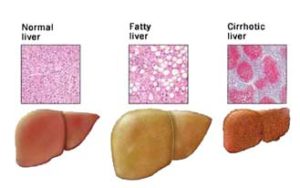
Fatty liver disease, which is also called simply “fatty liver,” is a liver condition in which large fat deposits accumulate within the liver. It’s a manifestation of a larger-
Symptoms
Fatty liver disease usually has no overt symptoms and is discovered as a result of blood tests followed up on by medical imaging such as ultrasound scanning. Fatty liver usually produces elevation in key liver enzymes which reveal themselves in blood tests, and an examination of the liver using imaging technology is a good follow-
Normally, the tests that reveal fatty liver are taken to diagnose something else, and the presence of fatty liver disease is discovered by accident, as it were. If fatty liver is found, the next step in the diagnostic procedure is to distinguish between alcoholic and non-
Non-
The most common single cause of fatty liver disease, as with other liver illnesses, is excessive alcohol consumption. For that reason, once the disease is found, the next step is an assessment to confirm or rule out alcohol abuse as a cause. If it’s found that the patient is not an alcohol abuser (takes no more than two drinks a day), then a diagnosis of non-
Causes of fatty liver disease other than alcohol can include obesity, diabetes, hepatitis (a swollen or enlarged condition of the liver which is often, but not always, due to a viral infection), and early stages of cirrhosis of the liver.
Treatment
The reason it’s important to identify the correct cause of fatty liver disease (or one of the reasons) is because fatty liver disease is rarely treated directly. Rather, treatment is applied to the underlying cause, which means the underlying cause needs to be identified.
Obviously, if the cause is alcohol abuse the treatment is cessation of drinking, with professional guidance and help if the abuse takes the form of alcohol addiction. If the cause is obesity, gradual weight loss is indicated. (Too-
Fatty Liver Disease And Diet
Many of the conditions causing non-
Complications
On rare occasions, fatty liver disease can give rise to complications which may be a serious concern. A worst-
Some doctors believe that fatty liver disease increases the risk of heart and cardiovascular illness; however, this is intrinsically difficult to verify. The problem is that many of the common causes of fatty liver disease, including obesity, diabetes, and alcohol abuse, also increase the risk of cardiovascular disease. Is a statistical connection between fatty liver and cardiovascular disease indicative of a direct causal relationship, or is it simply that many of the causes of one condition also cause the other? It’s difficult to say; however, since treatment of fatty liver disease calls for treating the underlying condition in any case, arguably it makes little practical difference one way or the other.
Fatty Liver Disease And Serious Liver Diseases
In many cases, fatty liver disease is an early indicator of, or else caused by, more serious liver diseases. These include fibrosis of the liver, cirrhosis of the liver, infectious hepatitis, and cancer of the liver. These illnesses call for close monitoring and aggressive treatment, and if they progress far enough may require a liver transplant. For this reason, fatty liver disease, although not dangerous in itself, should always be taken seriously and approached as a possible sign of serious health problems. If the problem can be treated and eliminated while still manifesting as nothing more serious than globules of fat in the liver, a lot of trouble can be headed off before it arises.